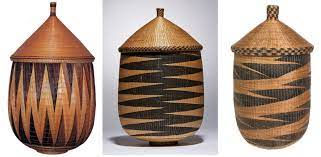African Basketry - Rwanda
- Moriamo A. Onabanjo

- Jan 16, 2024
- 3 min read
History
Weaving has been an integral part of African culture for thousands of years, with the practice encompassing different forms like baskets and bags. This art has not only impacted societies but it has also been passed down from generation to generation. The oldest known basket carbon-dated between 10,000 and 12,000 years, was discovered in Faiyum, Upper Egypt. This basket is older than any proven archaeological pottery findings. Due to their construction from perishable materials, baskets rarely survive. Nevertheless, an imprint of the weave on fragments of clay pots, formed by packing clay on the basket and shooting walls, is the most common proof of basketry knowledge.
Every woven object has a story to tell about long-standing African traditions, a timeless skill traditionally mastered by women, time-consuming, and complex. African tribes have been creating this art form using existing local resources such as reeds, grass, raffia, or palm fibers, with designs, patterns, and shapes specific to each group's place, culture, and needs.
Production Process
African tribes use four distinct weaving methods, namely coiling, plaiting, twining, or checkerboard. To begin weaving, plant fibers are washed, stripped, and often dyed before being woven into specific patterns and shapes. What was once an essential and functional part of their culture has now evolved into a highly expressive contemporary art form. The techniques of basket and textile weaving have come a long way.
Uses
Household basket containers were traditionally used for storing and serving food and beverages as well as filtering beer during its production process. They were also used to store spices and tobacco. Apart from secular uses, these containers were also used for non-secular purposes such as money banks, jewelry boxes, and divination vessels. They were often intricately designed with lids and decorations and sometimes strengthened with leather or bark to ensure durability. In some cultures, rice storage stacks were even included as part of a bride's dowry. Other woven fiber products included sleeping and eating mats, fish traps, handbags, and carry baskets.
Rwanda Basket Weaving
Weavers from different tribes in Rwanda, which is also known as "the land of a thousand hills," create beautiful sisal bowl baskets that symbolize peace, reconciliation, self-reliance, and hope. For centuries, women in Rwanda have been crafting baskets by hand. They use these baskets for transporting goods, carrying food, and as decorations during weddings and baby christenings.
In Rwanda, hand-woven baskets are given as gifts to celebrate significant life events like weddings, births, and graduations. Each basket is a result of love and hard work, and it sometimes takes several hours to complete one. Rwanda's 5,000 Franc banknote features two traditional baskets: the agaseke and the inkangara basket. Although the two baskets may appear similar in the banknote drawing, they have remarkable differences.
Agaseke Basket
Agaseke is a type of traditional Rwandese woven basket. It has a flat circular base that is taller than it is wide, with a sloped conical fitted lid. It is typically made of natural native fibers in off-white colors that have naturally dyed patterns in colors like purple, green, black, yellow, and red. Each agaseke can have numerous patterns displayed on its sides, each with its significance.

As a communal leisure activity, Tutsi women of the ruling class used to produce the Agaseke baskets with conical lids in various sizes by using coils of grasses finely sewn together. Combining functionality with bold graphic motifs, the baskets would be gifted or used to store precious objects like beads or amulets. The Tutsi people of Rwanda, Central Africa, are known to be some of the world's best weavers when it comes to basketry.
Inkangara Basket
The inkangara, also known as agakangara, is a basket with a lid that comes in various sizes and features traditional black or red decorative patterns. Unlike the agaseke, the inkangara has a different shape, function, and weaving technique. It is wider, sturdier, and has a simpler lid that is often decorated with a checkerboard pattern called ishaka or the sorghum spike.

The inkangara is a double-layered basket made using a wickerwork technique called igihisi, which is also used for panels and screens. The inner core is made of rigid bamboo splints woven together with raffia or sisal strands and further adorned with wedge weave to create the outer surface's bold and crisp designs. The fine outer surface is typically made of papyrus, Cyperus latifolius grass (intaratara), and the bark of banana leafstalks, covering a coarser deep layer made with narrow, rigid bamboo splints twined with fiber strands. The two different layers are sewn together, creating a sturdy and elegant basket.





Comments